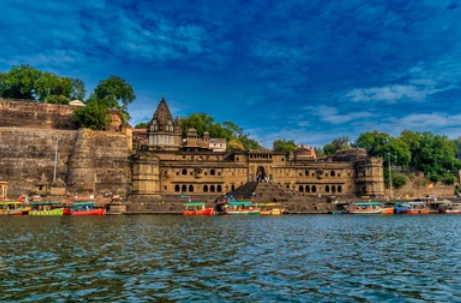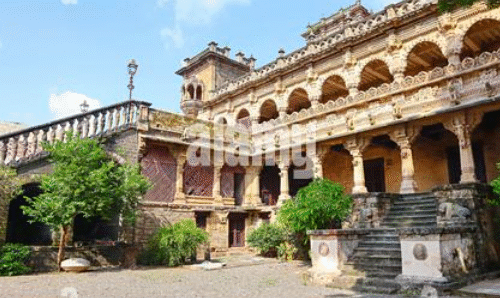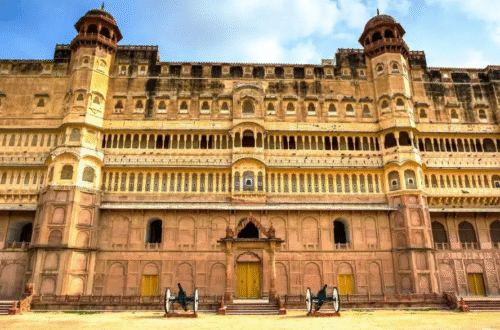Narmada Fort, also known as meheshwar Fort, stand proudly in the heart of India, telling stories of bravery, devotion, and beauty. There we provide you all the information about this fort and all the details related to this fort. all these kind of the information which is very usefull and informative for you.
Introduction of Narmada Fort
Narmada Fort, also known as Maheshwar Fort, stands proudly in the heart of India, telling stories of bravery, devotion, and beauty. This historic fort lies in Maheshwar, a peaceful town in Madhya Pradesh, on the banks of the sacred Narmada River. Over the centuries, the fort has grown into a place of great importance, admired for its architecture, spiritual value, and cultural influence. Today, it attracts visitors from around the world who want to explore its past and experience its calm surroundings.
Let’s take a deeper look into the story of Narmada Fort and understand why it still holds such a strong place in India’s heritage.
History of Narmada Fort
The roots of Narmada Fort go back nearly a thousand years. Built in the 11th century, the fort has seen many rulers and witnessed major changes in Indian history. It was the Holkar dynasty that built the fort, but its true transformation happened during the rule of Queen Ahilyabai Holkar in the 18th century.
Ahilyabai made Maheshwar her capital and decided to give new life to the fort. She renovated its walls, added temples, and developed its courtyards, turning it into a grand and spiritual space. Under her leadership, the fort became not just a defense structure, but a center of art, culture, and religion.
Her rule is remembered as a golden age for Maheshwar. The town became a cultural hub, and the fort became a symbol of her leadership and vision. Her contributions made the fort a jewel of central India.
Location and Significance
The location of Narmada Fort makes it even more special. It sits on the northern bank of the holy Narmada River, one of the seven sacred rivers in Hinduism. This gives the fort both a strategic advantage and a spiritual charm.

In ancient times, the river made the area an ideal location for trade and transport. From its high walls, one can see wide views of the river and the forests beyond. This location helped rulers defend the region and also allowed for peaceful connections with nearby kingdoms.
At the same time, the river adds a divine touch. Devotees believe the Narmada has the power to wash away sins, and its presence brings peace to the fort’s atmosphere. This makes the fort not just a structure of stone and wood, but a living part of India’s spiritual soul.
Read About:- Bhorakhiya Fort : Exploring the History, Location, Design, and Architecture
Architectural Design
When visitors walk into Narmada Fort, they feel like stepping into another era. The fort’s architecture is a perfect mix of Maratha and Rajput styles. Every corner, every carving, and every archway has a story to tell.
The walls are strong and tall, built to protect the fort from attacks. Yet, they also have beautiful details carved into them, showing scenes from nature and mythology. The wooden balconies and windows are designed with great care, reflecting the skills of artists from centuries ago.
One of the main attractions inside the fort is the Darbar Hall. This hall was where the queen held meetings and welcomed guests. The hall has delicate carvings, floral patterns, and traditional designs that show the artistic richness of that time.
There are also several temples inside the fort. Each temple has a unique design, with stone idols and peaceful courtyards. These temples make the fort not just a royal place, but also a space for worship and spiritual connection.
Cultural and Spiritual Importance
Narmada Fort is not just a piece of history. It is also a living part of India’s spiritual journey. The temples inside the fort are still active today. Priests perform daily rituals, and festivals are celebrated with great joy and devotion.
The Ahilyeshwar Temple, built by Ahilyabai Holkar, is the most famous among them. It is dedicated to Lord Shiva and attracts devotees from across India. The temple has a calm atmosphere that fills visitors with peace.
The ghats near the fort, which lead to the Narmada River, are also important. People come here to take a dip in the river, offer prayers, or simply sit in silence. Many believe that sitting on the ghats during sunrise gives them a sense of inner peace.
Every year, cultural events and traditional music programs are held in and around the fort. These events help keep the region’s customs alive and share them with younger generations.
Preservation and Modern-Day Relevance
In today’s world, preserving such heritage sites is very important. Thankfully, Narmada Fort has received the attention it deserves. A part of the fort has been turned into a heritage hotel, allowing tourists to stay within its royal walls. This has helped bring more visitors and has supported efforts to maintain the fort.
Guests at the heritage hotel get to experience the life of royalty. They stay in beautifully restored rooms and enjoy local cuisine. This setup creates jobs for locals and helps keep Maheshwar’s culture strong.
The local government and cultural organizations also take steps to clean and restore parts of the fort that have worn down over time. These efforts protect the fort’s history and give future generations a chance to see it in its full glory.
Tourism and Visitor Experience
A visit to Narmada Fort is more than just a sightseeing trip. It’s a complete experience that touches every sense. As visitors walk through its halls, touch its stones, and look out over the Narmada River, they feel connected to a past that still lives on.

The fort is open to all. Families, solo travelers, history lovers, and spiritual seekers all find something special here. Local guides tell stories of bravery, devotion, and royal life, making the experience even richer.
Near the fort, small shops sell local crafts, hand-woven Maheshwari sarees, and traditional jewelry. This gives visitors a chance to take a piece of Maheshwar’s culture home with them.
Lesser-Known Facts
Not many know that Maheshwar was once considered for being the capital of the Holkar kingdom before Indore was chosen. Also, Ahilyabai Holkar did not only build temples in Maheshwar but across India, including parts of Varanasi, Somnath, and Ayodhya.
The fort’s architecture also includes secret passageways and hidden chambers that were used for protection and movement during attacks. These features show the smart planning and skillful design that went into its construction.
Final Thoughts
Narmada Fort is a shining example of India’s history, culture, and spirituality coming together in one place. It tells the story of a brave queen, a sacred river, and a city that grew under the light of wisdom and devotion.
Today, as people seek deeper connections with the past, places like Narmada Fort offer answers. They show us the strength of heritage, the beauty of tradition, and the power of vision.
Whether you visit for its architecture, its riverfront view, or its peaceful temples, Narmada Fort promises a meaningful experience. It remains a living symbol of India’s rich soul and welcomes all who wish to explore it.
book your journey here.. Click Here





One comment on “Narmada Fort: A Glimpse into History, Architecture, and Spirituality”